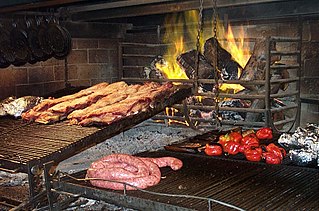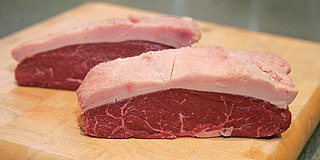
A beefsteak, often called just steak, is a flat cut of beef with parallel faces, usually cut perpendicular to the muscle fibers. In common restaurant service a single serving has a raw mass ranging from 120 to 600 grams. Beef steaks are usually grilled, pan-fried, or broiled. The more tender cuts from the loin and rib are cooked quickly, using dry heat, and served whole. Less tender cuts from the chuck or round are cooked with moist heat or are mechanically tenderized.

Brazilian cuisine is the set of cooking practices and traditions of Brazil, and is characterized by European, Amerindian, African, and Asian influences. It varies greatly by region, reflecting the country's mix of native and immigrant populations, and its continental size as well. This has created a national cuisine marked by the preservation of regional differences.

A fried egg is a cooked dish made from one or more eggs which are removed from their shells and placed into a frying pan and fried. They are traditionally eaten for breakfast in many countries but may also be served at other times of the day.

Chorizo is a type of pork sausage originating from the Iberian Peninsula. It is made in many national and regional varieties in several countries on different continents. Some of these varieties are quite different from each other, occasionally leading to confusion or disagreements over the names and identities of the products in question.

Asado is the technique and the social event of having or attending a barbecue in various South American countries, especially Argentina, Chile, Paraguay, Peru and Uruguay where it is also a traditional event. An asado usually consists of beef, pork, chicken, chorizo, and morcilla, all of which are cooked using an open fire or a grill, called a parrilla. Usually, red wine and side dishes such as salads accompany the main meats, which are prepared by a designated cook called the asador or parrillero.

Churrasco is the Portuguese and Spanish name for grilled beef prominent in the cuisines of Brazil, Uruguay, and Argentina. The term is used in other Spanish- and Portuguese-speaking countries for a variety of different meat products.

The oldest known book on Portuguese cuisine, entitled Livro de Cozinha da Infanta D. Maria de Portugal, from the 16th century, describes many popular dishes of meat, fish, poultry and others.

A schnitzel, colloquially known in Australian English as a schnitty, is a thin slice of meat. The meat is usually thinned by pounding with a meat tenderizer. Most commonly, the meat is breaded before frying. Breaded schnitzel is popular in many countries and is made using veal, pork, chicken, mutton, beef, or turkey. Schnitzel is very similar to the dish escalope in France and Spain, panado in Portugal, tonkatsu in Japan, cotoletta in Italy, kotlet schabowy in Poland, milanesa in Latin America, chuleta valluna in Colombia, chicken chop in Malaysia, and chicken-fried steak and pork tenderloin of the United States.

The milanesa is a variation of the Lombard veal Milanese, or the Austrian Wiener Schnitzel, where generic types of breaded cutlet preparations are known as a milanesa.

Flank steak is a cut of beef steak taken from the abdominal muscles of the cow, located just behind the plate and in front of the rear quarter. It is a long, flat cut with a significant grain, and is known for its bold flavor and chewiness.

Picanha is a cut of beef first made popular in Brazil, and later adopted in Portugal. It consists of the final part of the biceps femoris muscle, at the bottom of the animal, and its fat cap. In recent years the cut has become popular in most of Latin America and has become popular for barbecue.

A rib steak is a beefsteak sliced from the rib primal of a beef animal, with rib bone attached. In the United States, the term rib eye steak is used for a rib steak with the bone removed; however, in some areas, and outside the US, the terms are often used interchangeably. The "rib eye" or "ribeye" was originally, the central portion of the rib steak, without the bone, resembling an eye. The rib steak can also be prepared as a tomahawk steak which requires the butcher to leave the rib bone intact, french trim the bone and leave it at least five inches long. The tomahawk steak resembles the Native American tomahawk axe from which it gets its name.

Many regional cuisines feature a mixed grill, a dish consisting of an assortment of grilled meats.

Uruguayan cuisine is a fusion of cuisines from several European countries, especially of Mediterranean foods from Spain, Italy, Portugal and France. Other influences on the cuisine resulted from immigration from countries such as Germany and Scotland. Uruguayan gastronomy is a result of immigration, rather than local Amerindian cuisine, because of late-19th and early 20th century immigration waves of, mostly, Italians. Spanish influences are abundant: desserts like churros, flan, ensaimadas yoo (Catalan sweet bread), and alfajores were all brought from Spain. There are also all kinds of stews known as guisos or estofados, arroces, and fabada. All of the guisos and traditional pucheros (stews) are also of Spanish origin. Uruguayan preparations of fish, such as dried salt cod (bacalao), calamari, and octopus, originate from the Basque and Galician regions, and also Portugal. Due to its strong Italian tradition, all of the famous Italian pasta dishes are present in Uruguay including ravioli, lasagne, tortellini, fettuccine, and the traditional gnocchi. Although the pasta can be served with many sauces, there is one special sauce that was created by Uruguayans. Caruso sauce is a pasta sauce made from double cream, meat, onions, ham and mushrooms. It is very popular with sorrentinos and agnolotti. Additionally, there is Germanic influence in Uruguayan cuisine as well, particularly in sweet dishes. The pastries known as bizcochos are Germanic in origin: croissants, known as medialunas, are the most popular of these, and can be found in two varieties: butter- and lard-based. Also German in origin are the Berlinese known as bolas de fraile, and the rolls called piononos. The facturas were re-christened with local names given the difficult German phonology, and usually Uruguayanized by the addition of a dulce de leche filling. Even dishes like chucrut (sauerkraut) have also made it into mainstream Uruguayan dishes.

A steak sandwich is a sandwich prepared with steak that has been broiled, fried, grilled, barbecued or seared using steel grates or gridirons, then served on bread or a roll. Steak sandwiches are sometimes served with toppings of cheese, onions, mushrooms, peppers, tomatoes, and in some instances fried eggs, coleslaw, and french fries.

Lomo a lo pobre, bistec a lo pobre, or bife a lo pobre is a dish from Peru and Chile. The ingredients are beef tenderloin topped with one or more fried eggs and French fries. Unlike steak and eggs, lomo a lo pobre is eaten as a lunch or dinner.

Breaded cutlet or braised cutlet is a dish made from coating a cutlet of meat with breading or batter and either frying or baking it.
The Prego, also known as bitoque do prego, called prego no prato when served as a dish or prego no pão when served as a sandwich, is a typical Portuguese dish. It consists of a small beef patty which is normally served as a standalone dish or a sandwich, usually on a bolo do caco.

















